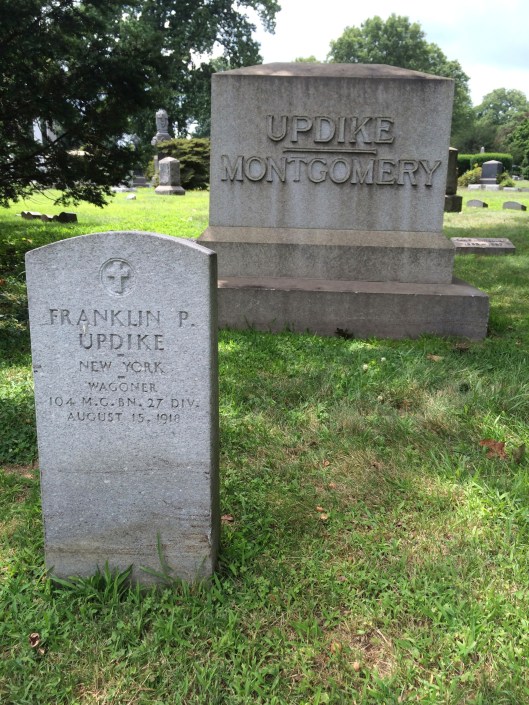Ulysses S. Grant III died fifty years ssgo today. To put his long life in some perspective: Grant was present at Mount McGregor when his grandfather died in July 1885; graduated with Douglas MacArthur in the West Point Class of 1903; worked as a White House aid in the Theodore Roosevelt Administration; married Secretary of State Elihu Root’s daughter in 1907; served in the Pacific and Caribbean during the Philippine and Cuban Insurrections, at Veracruz and on the Mexican Border during the Punitive Expedition, in France during the Great War, and in Paris after the Armistice where he helped write the Treaty of Versailles. All before his fortieth birthday.

The 1907 Root-Grant wedding was a major event in Washington society and covered by newspapers across the country.
A few weeks ago at the Tomb I chanced upon a well-known figure from the Civil War blogosphere who grimaced when I mentioned that this month marks the anniversary of Grant III’s death. I wasn’t surprised and cannot say I blame him; Grant is today best known as the first chairman of the doomed United States Civil War Centennial Commission. Many readers will know that the Civil War centennial did not proceed smoothly, coming as it did—not coincidentally—during the Civil Rights Movement. President Eisenhower signed the enabling paperwork creating the Centennial Commission in 1957, the same year that Little Rock High School was desegregated. Grant turned seventy-six the year he assumed the chairmanship of the organization he led for the next four tumultuous years. His reputation, for all he had done over his long career, has never recovered.
Writing in his 2012 book American Oracle David Blight offers a scathing indictment of Grant as “a staunchly conservative superpatriot and racist.” When one looks at U.S. Grant III’s life from a certain perspective it is difficult to argue with Blight’s assessment and I won’t defend Grant or his record in their entirety here. That said, a more charitable interpretation might be that Grant, born in 1881, reflected the views and attitudes of most white Americans born in his era. He toiled for decades in a U.S. Army officered with the sons and grandsons of many of the men who had once fought against his grandfather. Who among us can say with certainty what we would have done had we lived in another place and time?
After the Great War and Versailles Peace Conference Grant held numerous military posts in the 1920s, oversaw part of the Civil Conservation Corps in the early years of the Franklin Roosevelt Administration, and quietly prepared for war with other officers of the Second Corps Area on Governors Island in the late 1930s while Germany and Japan rattled their sabers. Too old for combat service when Pearl Harbor finally came, he coordinated civil defense for the continental United States during the Second World War. Grant’s aptitude as a civil engineer and apparent interest in urban planning led him over this long career to many other positions, including a stint after World War II as a member of the National Capital Park and Planning Commission in Washington D.C. and president of the American Planning and Civic Association.
All of these accomplishments were in the end tarnished by that 1957-61 stint as Centennial Commission chairman. Had Grant and his allies had their way, the Civil War centennial would have been filled with Civil War rrenactments emphasizing the courage and fighting spirit of Union and Confederate men and officers while studiously avoiding the war’s causes, consequences and unfinished business. The controversies are too detailed to go into here. Things began escalating however until in 1961 New Jersey officials publicly called on Grant to resign. There was pressure from other quarters as well. Grant held on for several months until eventually submitting his resignation to President Kennedy in September 1961. The pretense was his wife Edith Root Grant’s health and indeed Mrs. Root had been ailing for some time, confined now to the family summer house in Clinton, New York for many months as her health deteriorated. General Grant was sincere in his concern for his wife, but the public pressure regarding the Centennial Commission was intense and growing. Mrs. Grant died in 1962 and her widower husband carried on for six more years.

President and Bess Truman with Ulysses S. Grant III (far right), Admiral William Leahy (third from left) and others at the Lincoln Memorial, February 12, 1948.
His grandfather, General and President Ulysses S. Grant, in a very real sense had died at the right time in 1885; with the war over for two decades, Americans, especially white Americans, were eager to move on. Reconstruction had ended eight years previously and General Grant’s funeral was the reconciliationist event that organizer Winfield Scott Hancock, the 60,000 marchers, hundreds of thousands of attendees, and millions of other Americans had wanted it to be. President Grant, try though he did, was unable to heal the nation’s wounds during his administration; the intransigence he faced was just too great. Ironically it was the failures of Grant and the country that contributed to his grandson’s resignation nearly a century later.
Ulysses S. Grant too died during a decisive moment in American history. His passing came on the third day of the 1968 Democratic National Convention, when the party met in the tense August heat of Chicago. With the Vietnam War going poorly and after the many assassinations and riots that had already taken place that year, civil unrest was almost inevitable. We still face the fallout from those tragic days. Much of the worst of it came on August 28, when police and protesters clashed in a violent conflict broadcast on network television and watched live by tens of millions people. Ulysses S. Grant III died at the family home in Clinton, New York the following day.
(images/top, Library of Congress; bottom, National Archives)
















